Hello, I’m ArchaeusDota, and today I’m here to share the first part of my Rhinos primer with you. I’ve been playing this deck for months at this point, with a reasonable amount of success, both online and in paper. I truly believe that this is one of the best decks in the format, and I’m excited to present my interpretation of the archetype to you!
If you are interested in more Rhinos content, you can check this link.
General concept of the archetype
Rhinos main gameplan
Rhinos (Or Crashing Footfalls) is a very versatile tempo deck which has elements of both aggro and control gameplay. It uses the Cascade mechanic to ensure casting Crashing Footfalls to generate an impressive boardstate and apply fast pressure in the form of powerful, trampling creatures while disrupting your opponents’ gameplan with your own interaction.
For those of you who don’t keep up with the metagame and are curious how Rhinos look like after the release of Dominaria United, a typical decklist:
Why is it good? What is the best metagame for this deck?
The main strength of the deck is the value you generate from your three mana cascade cards. Very few other decks in the format can compete with the value of a turn three Shardless Agent into two 4/4 Rhinos. This is the primary engine of the deck and something a lot of opponents simply struggle to keep up with.
The secondary strength is the versatile interaction you can build into the deck. Between spot removal, mass removal and free counterspells, you cover the whole format in terms of being able to slow down basically anything you face. Very few decks have such powerful and efficient tempo cards as Rhinos.
You are generally happy to see your opponent try to play to the board with mana dorks, most creatures or vulnerable planeswalkers. Your game-plan often quite literally tramples over any of that. You should generally be more wary when, for example, opponents hold up mana and don’t play anything.
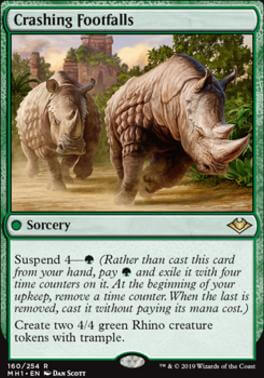
In terms of a favoured metagame, Rhinos dominate in metas of other midrange or creature based strategies. The sheer amount of removal and trample damage often overwhelms these decks. Combo/Big Mana is a decent meta as well, with your ability to put down pressure with zero mana interaction being key against other decks that try to go fast. Control-heavy metagames with many counterspells may be trickier, though I believe with enough practice and deckbuilding you can do just fine there as well.
What are its biggest weaknesses?
Almost every deck has weaknesses. Though few in my opinion, you can be weak to cheap counterspells, Teferi, Time Raveler and certain combo strategies that goldfish faster than you. Rhinos definitely punish decks that try to drag out the game – you just need to be careful when your opponent is presenting a strategy which makes your creatures redundant or presents a more dangerous threat (which is rare).
Some decks also run very effective and annoying hate pieces, causing you massive damage, killing your tokens or providing a permanent answer to cascade in the form of a Chalice of the Void. With recent additions however a lot of the threat from these hate cards has been mitigated.
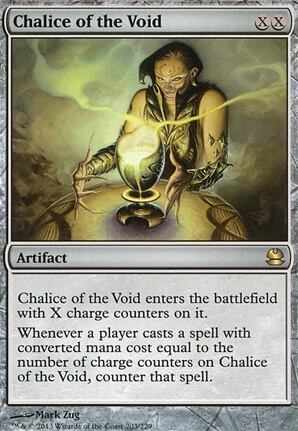
Which version of Rhinos is the best?
Before Dominaria United, Temur was the predominant version of Rhinos. Its ability to have a set of simple lands and access to cards such as Blood Moon meant it was both easy and effective from a deckbuilding perspective. 4C variants existed with Omnath, Locus of Creation and Yorion, Sky Nomad, however these dropped off in popularity due to the inability to play the aforementioned red enchantment along with a generally trickier manabase. It also meant the deck tended to have longer games, which is in my opinion not what you want when you have such a powerful aggressive plan. I fundamentally believe that Yorion doesn’t fit this deck, as we want our gameplan to be as consistent and concise as possible. Yorion and Omnath do not help enable this idea of focus.
With the introduction of the new set things have changed. Leyline Binding is a blessing for the deck, being more than three mana (so it doesn’t disrupt Cascade) and answering virtually any permanent in the game at instant speed is an exceptionally strong addition to the archetype. Combined with the card Ardent Plea and potentially Teferi, Time Raveler, it gives you a strong reason to play at least 4c now. I’ll go over the manabase further on in this article, but I can already tell you that I believe that 5c is worth the very slight awkwardness in your manabase to have access to a one mana Leyline Binding – a truly exceptional card. Let’s have a look at the cards!
Maindeck – analysis card by card
Engine
Crashing Footfalls

The primary strategy of the deck, I am strongly opposed to ever cutting this card since you regularly go through all four over the course of a game and cannot really afford to miss on a Cascade trigger at any point. You cast a spell with Cascade, reveal cards until you hit Footfalls and then put it on the stack. Generally, it is a good idea to suspend this on turn 1 if in your opening hand with a few exceptions.
- If you have a Dead // Gone to interact you may want to hold this up if you think they are playing a creature based strategy.
- I have found that vs Burn it is probably unwise to ever suspend this card – Eidolon of the Great Revel and Roiling Vortex are not friendly when you consider that the Suspend mechanic is not a may, but a must.
- If you have a Force of Vigor in hand and require a cheap green spell to pitch to it – this is generally it.
Throughout all matches, be very mindful of how many copies of this card remain in your deck, hand, graveyard and exile. Don’t get caught out cascading into nothing because the 4th copy is in your hand! Do not forget combat tricks where trample becomes relevant (killing a blocking creature, thus dealing more damage to face). Note you cannot suspend this card if it is named by Meddling Mage.
Violent Outburst, Shardless Agent, Ardent Plea (in the 4c versions)
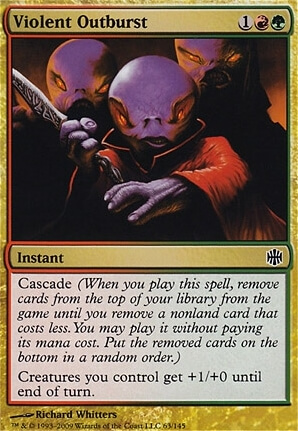
Your main enablers. Shardless Agent is generally the best one, especially when your opponent is not playing at instant speed. Violent Outburst is an incredible combat trick (wait for the opponent to attack then make two 4/4’s at instant speed and make favourable blocks) and a great way to play around counterspells by acting on your opponent’s turn, forcing them to tap out. Ardent Plea is the weakest option, which is why I only recommend a couple, though the Exalted trigger should not be underestimated: we have trample creatures! Demonic Dread is the only other consideration worth mentioning, however requiring a creature to target makes it unplayable to me. It is critically important to fetch correctly to have access to all three of these cards on turn three. Note that Violent Outburst can be used to deal an extra 2-3 damage due to the +1/+0 text on the card. Do not put Ardent Plea in your graveyard after resolving, it is an enchantment!
Interaction
Force of Negation
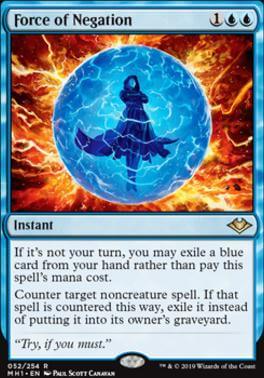
An incredible card which lets you tap out for your Cascade while being able to interact on their turn for the price of another blue card (something our deck doesn’t readily lack). Relatively rarely a dead card, I would always force an Aether Vial or Sigarda’s Aid, where the majority of the rest of the deck is likely to be creature based. Not a card to ever remove from the main deck in my opinion. Note that if you Violent Outburst on their turn, Force also can be cast for its alternate cost – an incredible play pattern that can win you many games.
Leyline Binding
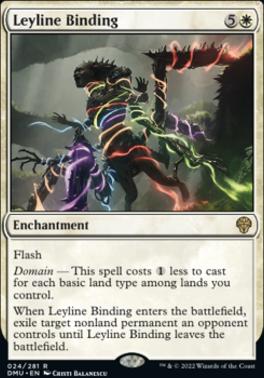
The new removal card people are watching closely. To me, it is the best removal spell in the format currently and provided you fetch correctly can be the sole reason you are able to win some games. The casting of this card requires little explanation, we’ll use it mostly on Chalice of the Void, Teferi, Time Raveler or Murktide Regents – permanents that used to be otherwise tough to deal with. In order to cast this on turn 2 for 1 mana, you must fetch the opposite shockland to the triome you fetched or played on turn 1.
Fire // Ice
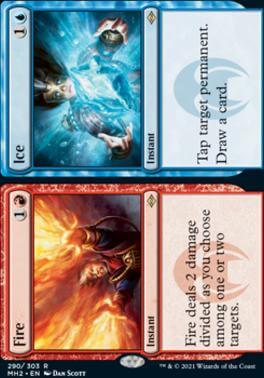
One of the strongest cards in the deck. First, it pitches to both Force of Negation and Fury as it is both Blue and Red off the stack. Then let’s mention the two halves separately:
Ice: Use this to tap down an opponents’ land in their upkeep, often effectively time walking them (and drawing a card!) or on troublesome creatures that we need to tap down. Occasionally you can wait until opponents end-step to tap a land, especially if they are playing a blue-based control deck and you suspect they might partially tap their mana for a threat or interaction spell such as Dragon’s Rage Channeler or Thoughtseize.
Fire: A versatility removal or burn spell. Killing multiple mana dorks is a dream, along with picking off Ragavans or dealing the final blow to a Omnath that has survived a Shardless Agent attack. You’d be surprised how many times this is lethal damage to your opponent.
Dead // Gone
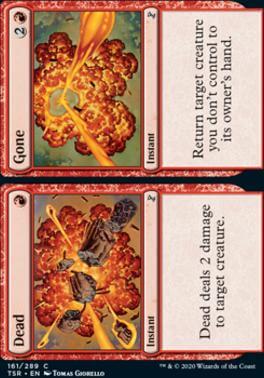
Not my favourite card but it does the job. This is your anti-Ragavan card that is a versatile removal spell against mana dorks, Esper Sentinels and other nefarious creatures. The second half can also be very useful in bouncing Murktide Regents, Urza’s Saga constructs or even a Ledger Shredder. Three mana isn’t ideal for this effect though, which is why we board this card out in plenty of matchups.
Fury
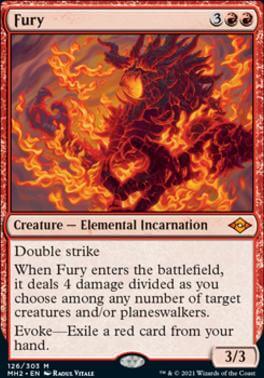
The premier removal spell. As with Force of Negation, we absolutely do not mind evoking this card if it puts us ahead on the board, and our Rhinos do the rest. I always kill Ledger Shredder on sight by evoking Fury, along with most Esper Sentinel boards, mana dork collections or annoying Planeswalkers on low loyalty such as Grist, the Hunger Tide. Almost never worth killing a Ragavan by evoking this in my opinion. Perhaps if your opponent has mulliganed to three it can be a consideration! Fury is also an amazing threat to tap-out for on turn five – usually done post-combat to finish off any large creatures that successfully blocked a Rhino and lived (not for long…).
Brazen Borrower
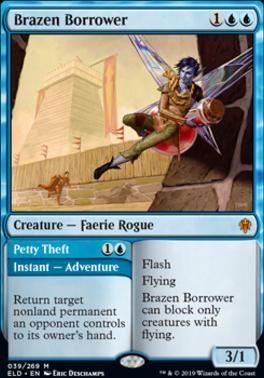
An excellent card in Temur builds. The tempo it provides along with a potential threat later on is a valuable card that interacts with most of the format. I think, unfortunately, this is a card that likely gets cut for Leyline Binding, which is a shame but for those still interested in playing Temur it’s an excellent choice no doubt. Its primary uses are on large Murktide Regents, Teferi, Time Ravelers and Urza’s Saga constructs. Those are just a few examples though – it’s reach is wide-ranging for sure.
Bonecrusher Giant
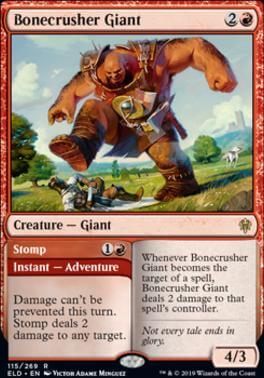
What was previously my absolute favourite card is now probably edged out of the 75. In the Temur version it remains an excellent choice and I often played this card over Dead // Gone since you had access to Gemstone Caverns to enable this on turn 1. It also functions as an amazing threat when your opponent has for example a Chalice of the Void or Flusterstorm you can simply play a three mana 4/3 with an Eidolon of the Great Revel-esque trigger attached. It also is a good threat to combo with Blood Moon in postboard games. Note that stomping their face is a more than acceptable way to win games.
Possible additions
Subtlety
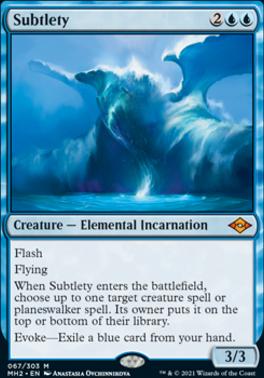
Many other Rhinos players enjoy this card quite a bit. I can evidently see its strength and agree that it’s a powerful card. Its ability to essentially time walk large creature decks such as Amulet Titan or Tron or pseudo-counter a Teferi, Time Raveler is enticing for sure. I find these situations to be a little lacklustre myself however and would prefer other cards, though I can definitely see playing 1-2 copies in the 75 if your metagame is heavy in Primeval Titans for example. Note that you can Subtlety your own Shardless Agent after the Cascade trigger has resolved to be able to draw it next turn and Cascade again.
Endurance
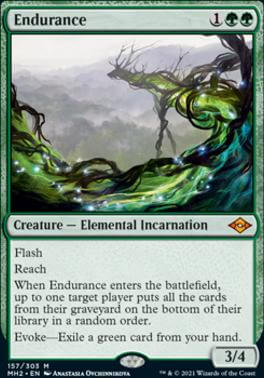
Super effective and surprisingly versatile, I don’t think I would register a decklist without four copies of this card in the 75. Its obvious application is versus graveyard strategies where you can potentially send a player’s graveyard to the bottom of their library at instant speed for zero mana. However against certain midrange strategies such as Jund or any deck with Kroxa, Titan of Death’s Hunger it can just be a great instant speed way to block a Ragavan while reducing the size of their Tarmogoyf for example. I’d generally say if you can wait to hardcast it then do so, as the body can be quite relevant, though if your opponent is going to generate immense value in the first two turns from their graveyard feel free to evoke to stop them in their tracks.
Prismari Command
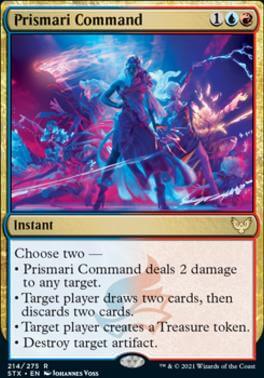
Another versatile card that pitches to both of our main-deck “free” spells. I like this card because of its flexibility: it can ramp you to a Fury, filter away excess lands or find land drops, kill a creature and an artifact or simply burn their face for two. This last mode shouldn’t be underestimated! This will generally be a turn four or five play since you’ll want to cascade at least once starting from turn three.
Fable of the Mirror-Breaker
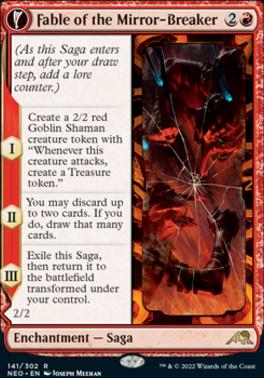
I think the only card I have not yet tested with. This is by choice: I am not disputing it’s power as a card but it seems to me that I would just rather have more Cascade spells instead of a three mana card that doesn’t combo super well (if you say Fable is good against cards like Chalice of the Void, then we don’t have Rhinos to copy anyway!).
Teferi, Time Raveler
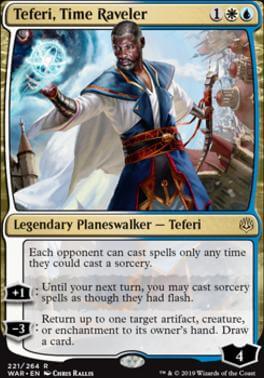
In my opinion, this card doesn’t fit well in a Rhinos deck. It’s very passive and doesn’t actually synergize too much except perhaps bouncing an Ardent Plea to re-cast the following turn. The passive is for sure strong but with so many Spell Pierces, Force of Negations and Mystical Dispute I’m not sure this is important to fight over, especially now that Leyline Binding is a card. If you do play it, be careful when choosing whether to draw or +1 to 5 as opponents may have Unholy Heat, Fury or Wrenn and Six.
Others (maybe Murktide Regent?)
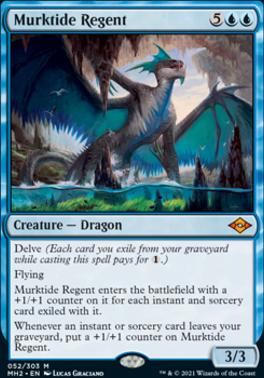
There are always around two flex slots in the main deck where I believe you can be a little creative. The core engine is so strong that these extra cards can be up to personal preference as I showed by winning with Temporal Mastery. DON’T PLAY THIS CARD – I was just showing that it’s up to you. I like Jace the Mind Sculptor for its ability to refill the hand, Murktide Regent and Become Immense for utilising the graveyard or perhaps even a Chandra, Torch of Defiance to keep burning your opponent every turn. You can adapt these final 1-2 cards to whatever metagame you intend to play in.
Cards I wouldn’t recommend
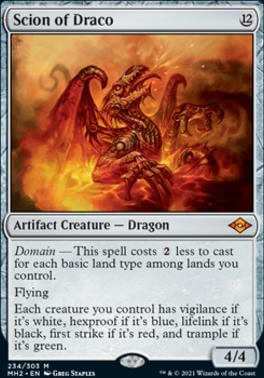
There are a few cards I don’t like at all. Scion of Draco is something everyone keeps asking me about, but the one thing this deck doesn’t need is more threats. Your Rhinos are the best threat you could ask for – your complete game plan should revolve around making as many as you can, as fast as you can. Between Leyline Binding, Fire // Ice and Dead // Gone, you have plenty of interaction that you need to cast on the first two turns instead of playing a 4/4 flyer that gets bounced by Teferi, Time Raveler. I’ve already explained why I don’t personally like Fable, Subtlety or Teferi. Those three are reasonable cards however, and not playing them is just my opinion.
The manabase
Generally the deck plays 24 lands. I think this number is good having experimented with 25 quite a lot. It’s very important to play at least ten or eleven fetches to ensure a smooth road to Cascade on turn three. You have UG, RG, UU, GG for a lot of your main spells as a start (with Fury being RR later on). Now that we have Ardent Plea and Leyline Binding you also need W on turn two ideally. I suggest running 12 fetches along with the Esper and Mardu Triomes. We need the triomes to have BW for Domain and to cast Leyline Binding, and since we only need one green mana in game one, it’s more important to have R and U options to fetch. You should run one of each since Misty Rainforest cannot fetch Mardu and Wooded Foothills cannot fetch Esper. I want Binding to cost 1 mana, so I always try to fetch one of the triomes on turn one so that I can then get the opposite fetch (Esper+Gruul or Mardu+Simic) for Domain on turn two. This will sort your first turns very well for the vast majority of games.
In previous Temur builds basic Mountain was good, however I no longer think we can support it though if I was in a specifically Burn-heavy meta I’d consider it. Running at least one Island and one Forest is necessary. I’ve never found the second Island to be that impactful, especially if you don’t run Brazen Borrower. Gemstone Caverns is great in Temur builds, and I’d recommend at least two in the 75, however with the white splash it’s no longer correct in my opinion. I’d never leave home without two canopy lands, as they really help mitigate flooding and since our spells are all cheap it’s no big deal at all. I prefer Fiery Islet to Waterlogged Grove since it casts Dead // Gone turn one. Note that those lands DO NOT enable Domain.
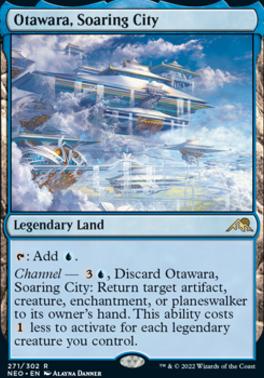
As far as Channel lands go, I think it depends on your expected meta. Boseiju is excellent in Tron, Hammertime and Amulet metas whereas Otawara is excellent in Control, Murktide and Four Colour metas. I think both a one-one split and two Otawaras are reasonable. If possible, try to avoid playing these as land drops unless you need them to Cascade. Remember that the land that they find off of Boseiju comes in untapped – potentially a big deal. Also remember you can Otawara your own Shardless Agent or Bonecrusher Giant in a pinch.
Sideboard options
Mystical Dispute
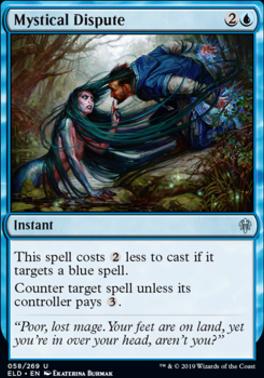
A pretty cool card to answer Teferi, Time Raveler, Spell Pierce or Ledger Shredder. You’d like to bring this in against any deck that plays at least a few important blue cards as well as matchups where you just need more counterspells (even if it costs three mana to cast) such as Living End or even perhaps Dredge. For as long as Teferi, Time Raveler remains a popular card I believe Mystical Dispute should remain at least a two or three-of in all sideboards.
Force of Vigor
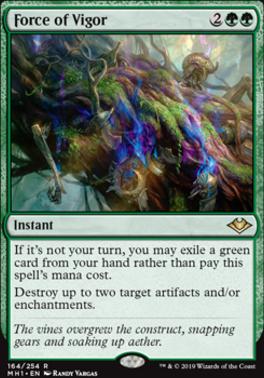
My personal favourite sideboard card. Having instant speed zero mana double disenchant is simply an absurdly powerful effect to bring in in artifact or enchantment heavy environments. This card fits Rhinos like a glove, being hyper tempo. I believe decks such as Amulet Titan and Hammertime will continue to be very popular, and Force of Vigor completely dominates these decks. If you can pitch a Crashing Footfalls that is ideal, though sometimes you have to pitch a Cascade spell in order to stop your opponent going too crazy and killing you. Remains a solid four-of to me until further notice.
Endurance
A vital card to deal with graveyard synergy decks that are often our toughest matchups. Decks like Living End, Dredge and Mill are some of the few decks that can out-power us on board or indeed mill us so we need a way to send their creatures back to the bottom of their libraries where they belong. Also just a great card against Murktide decks as well as Jund piles that involve Kroxa or Tarmogoyf. It’s markedly better than Leyline of the Void since the body is a relevant threat when opponents interfere with your cascading. It’s also just a nice Flash threat vs Control decks in general, especially when they’re running Snapcaster Mages.
Subtlety
A solid choice when your opponent is presenting a creature/planeswalker threat that will pose us a significant issue. Examples of this include Wurmcoil Engine, Primeval Titan or Teferi, Time Raveler. You can always bounce your own Shardless Agent after casting the Crashing Footfalls. I think this card lets you play further on into the game since you have a strong turn four tempo play that can swing for three flying damage afterwards.
Blood Moon and Magus of the Moon
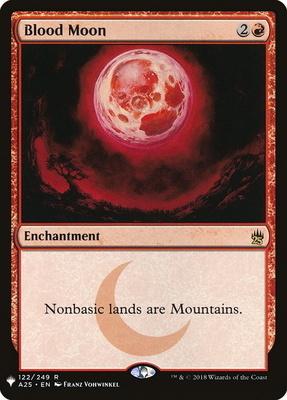
Super effective against any deck that tries to get greedy with their manabase and doesn’t rely on fetching basic lands. This card can be a game-ender against plenty of decks such as Tron, Primeval Titan or even sometimes UW Control. Both options provide different solutions to different problems. Magus is more aggressive but dies much more easily to removal, whereas Blood Moon doesn’t put direct pressure but is generally harder to remove. Overall I’d say in most wide metas Blood Moon provides a more dangerous threat, though if you know your meta is full of specifically Tron I’d maybe register some number of Magus of the Moon. In terms of Blood Moon effects with Leyline Binding, I think if Blood Moon really messes with their gameplan a lot then it’s not so important whether you can cast Binding or not. You can always board out 1-2 Binding if you are really worried about this.
Chandra, Awakened Inferno
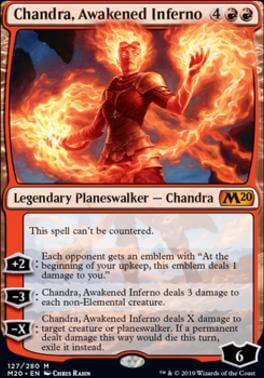
Not a common card, as getting to six mana can be a big challenge. You rarely get above five lands and even if you do, there’s a decent chance you’ll be cycling your canopy lands to find more Cascade spells instead. Chandra, Torch of Defiance seems like a more reasonable suggestion that I have tried a bit with above-average success. I don’t think giant threats are the answer to decks like UW Control – more Disputes and tempo cards function better in my opinion.
Unmoored Ego and others
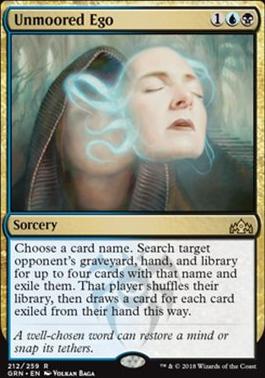
In my recent $4K that I won, I played two Unmoored Ego in my sideboard. I’d recommend this card as it helps fight decks that can go quicker than us. I used it against Glimpse of Tomorrow and Enchantress (naming Solitary Confinement) and it won me those matches I otherwise could easily have lost. Generally, since our deck doesn’t feature much card draw I am against one-ofs and think with the choices mentioned above you can create an incredible sideboard of flexible and powerful cards.
